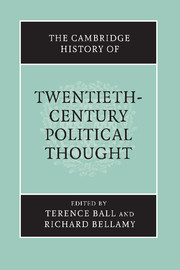Book contents
- Frontmatter
- Editors’ introduction
- Part I The changing fortunes of liberal democracy
- Part II Varieties of Marxism
- Part III Science, modernism and politics
- 15 Positivism: reactions and developments
- 16 Postmodernism: pathologies of modernity from Nietzsche to the post-structuralists
- 17 Weber, Durkheim and the sociology of the modern state
- 18 Freud and his followers
- 19 Modernism in art, literature and political theory
- 20 The new science of politics
- 21 Utilitarianism and beyond: contemporary analytical political theory
- Part IV New social movements and the politics of difference
- Part V Beyond Western political thought
- Biographies
- Bibliography
- Subject index
- Name index
- References
18 - Freud and his followers
from Part III - Science, modernism and politics
Published online by Cambridge University Press: 28 March 2008
- Frontmatter
- Editors’ introduction
- Part I The changing fortunes of liberal democracy
- Part II Varieties of Marxism
- Part III Science, modernism and politics
- 15 Positivism: reactions and developments
- 16 Postmodernism: pathologies of modernity from Nietzsche to the post-structuralists
- 17 Weber, Durkheim and the sociology of the modern state
- 18 Freud and his followers
- 19 Modernism in art, literature and political theory
- 20 The new science of politics
- 21 Utilitarianism and beyond: contemporary analytical political theory
- Part IV New social movements and the politics of difference
- Part V Beyond Western political thought
- Biographies
- Bibliography
- Subject index
- Name index
- References
Summary
In the late 1890s Sigmund Freud (1856–1939), who had been trained as a Viennese neurologist, created a new field, psychoanalysis, which was designed to understand and treat neurotic afflictions. Although not a political thinker per se, Freud contributed indirectly, and some of his followers directly, to modern political theory. Politically, Freud was something of a conservative liberal, sceptical in outlook and suspicious of utopian schemes. His followers did not always follow him faithfully down the trail he had blazed in the new discipline of psychoanalysis; nor did all agree with his political views. Some were conservative to the point of reaction, others radical Marxists and utopians. Some revised Freudian theory almost beyond recognition. All were alike, however, in finding in Freud the outline and essentials of a new and fruitful way of thinking about man and society.
Freud’s thought
An essential key to Freud’s thinking about psychopathology lies in the character of the last days of the Hapsburg Empire. A yawning gulf between reality and official ideology stimulated a general intellectual revolt and a search for the actualities beneath the pious formulae of public truth. This uprising was led by those ideally placed to see the discrepancy because they had nothing to gain from accepting the official view: the educated Jews. Mordant irony was their weapon for piercing the veil of the structure of formal beliefs. The cultural conflict between East and West that had its vortex in Vienna’s cosmopolitan intellectual life, and the sense that liberal culture was on the verge of being undermined, would be reflected throughout Freud’s mature thought (Zweig 1953; Roazen 1968; Johnston 1972; Schorske 1979).
- Type
- Chapter
- Information
- The Cambridge History of Twentieth-Century Political Thought , pp. 392 - 411Publisher: Cambridge University PressPrint publication year: 2003
References
- 1
- Cited by

